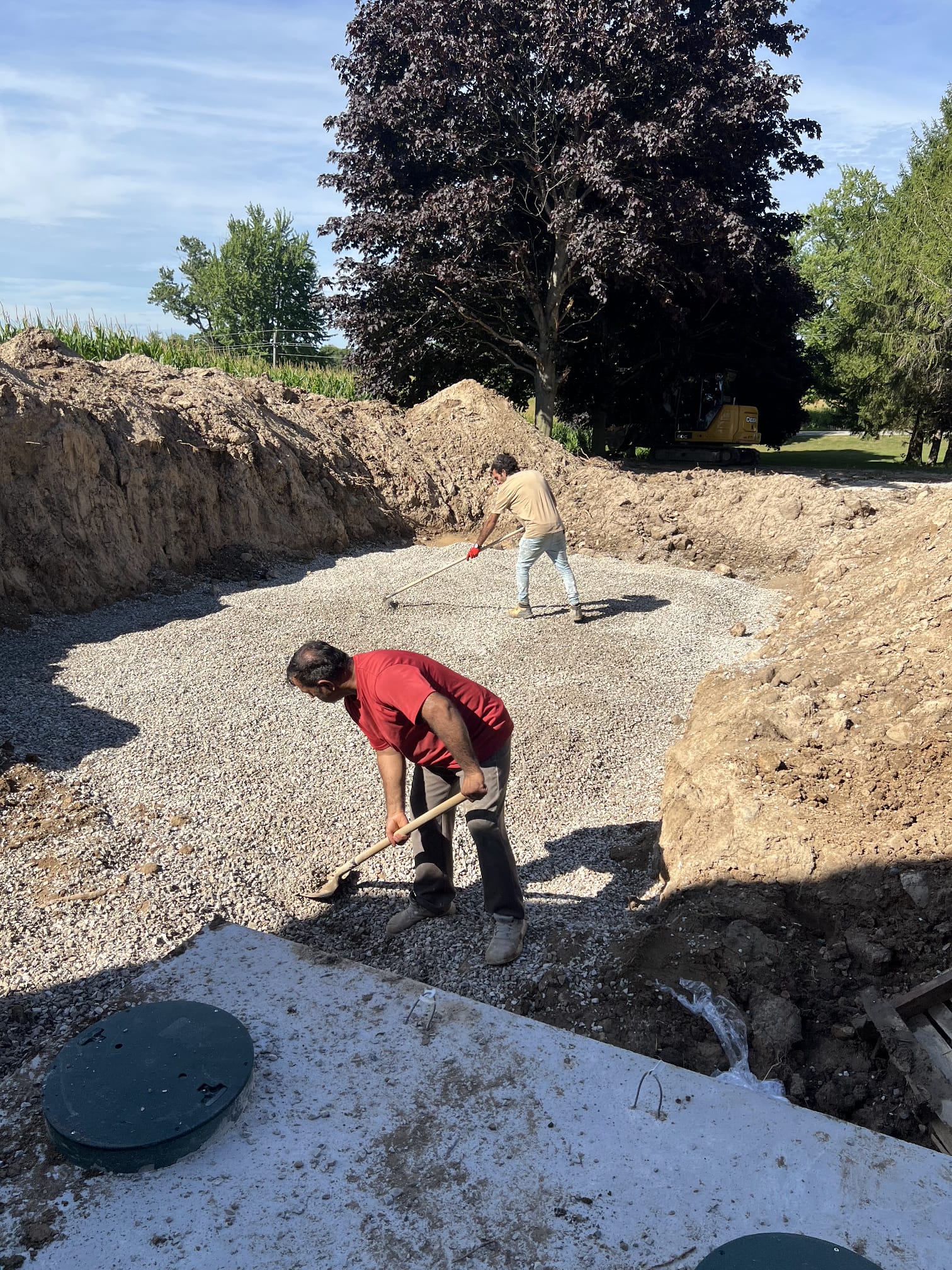Septic design Palmerston is the foundation of reliable wastewater management for rural and semi-rural properties in Palmerston, Ontario. A properly designed septic system ensures environmental safety, public health protection, and full compliance with the Ontario Building Code. Whether for a new build or replacing an aging system, professional septic planning is essential to avoid costly failures, protect groundwater, and secure municipal approval. With soil variability, seasonal climate extremes, and evolving land use in Palmerston, a licensed engineering approach guarantees your system functions year-round.
Local Factors Influencing Septic Design in Palmerston
Palmerston’s geography includes clay-heavy soils, rolling terrain, and significant rainfall, all of which impact septic design. These variables affect effluent absorption rates and may require engineered systems for performance and code compliance. Seasonal temperature swings also create freeze-thaw conditions that threaten shallow installations. Design professionals must consider slope, surface runoff, and subsoil depth when preparing plans. Ignoring Palmerston’s specific site challenges risks system failure, regulatory rejection, or contamination of surrounding water sources. Tailored design helps properties meet both functional and legal standards.
Ontario Building Code Requirements
Septic design Palmerston must follow Part 8 of the Ontario Building Code. This section sets rules for system sizing, tank volume, absorption field length, and minimum separation distances from structures and water sources. Every project in Palmerston requires approval based on these criteria, enforced by Wellington County’s building authorities. Non-compliant systems cannot be installed or transferred during property sales. The design must also include soil testing results and full layout diagrams. Properly navigating the code ensures installations are legal, safe, and long-lasting. Knowledge of current regulations gives designers an edge in streamlining approvals.
Site Evaluation and Soil Testing
Before design begins, a qualified professional performs a site inspection and percolation testing to determine soil suitability. Septic design Palmerston depends on how quickly soil absorbs effluent. Slow or compacted soils may need larger fields or alternative systems. Bedrock, shallow groundwater, or seasonal saturation can reduce options and increase complexity. Accurate testing identifies these issues early, guiding decisions that avoid failure or legal disputes. Properly executed evaluations support clear, data-driven design, which satisfies both municipal regulators and long-term property use.
Choosing the Right System Type
Conventional systems use gravity-fed tanks and trenches but are not always viable in Palmerston due to variable terrain and impermeable soils. In such cases, mound systems or pressure distribution fields become necessary. These engineered alternatives elevate effluent dispersal or use pumps to distribute it evenly through more limited or less absorbent soil. Septic design Palmerston involves matching the system type to local site conditions. A mismatch leads to poor performance or total system collapse. Design expertise ensures the chosen system handles current and future demands safely.
Elmid Design Inc: Trusted Experts in Septic Design
Elmid Design Inc specializes in septic design Palmerston and holds a Certificate of Authorization from Professional Engineers Ontario. Their engineering team delivers precise, code-compliant designs that consider soil, climate, topography, and future expansion needs. Known for technical accuracy and regulatory insight, Elmid Design Inc manages every phase, including testing, drawings, and permit preparation. This minimizes delays and maximizes system longevity. Their strong local experience ensures every project receives tailored attention, aligning system performance with Palmerston’s environmental demands and legal expectations.
Permit Application and Approval Process
The permit process begins once the design is finalized. Applicants submit the site plan, soil test results, and full system design to the local building department. Septic design Palmerston approval requires confirmation that the system complies with code and local bylaws. Inspectors often conduct site visits before issuing permits. Delays occur when applications are incomplete or design documents lack clarity. Working with Elmid Design Inc streamlines this process. Their complete documentation package and established working relationships with regulators improve approval speed and reduce the chance of rejection.
System Installation and Site Preparation
Once approved, the site must be prepped for excavation and installation. Septic design Palmerston should account for logistics like vehicle access, trench protection, and proximity to trees or structures. Excavators must follow plan specifications precisely. Deviation from depth or trench width risks system failure and noncompliance. Installation must occur in dry weather when soil compaction is minimal. Inspections happen during and after installation to verify code adherence. A professionally designed and executed installation prevents costly rework, future failures, and regulatory penalties.
Seasonal Challenges and Weather Effects
Palmerston’s winters bring extended frost depths and snow accumulation, which can freeze shallow lines or tank components. Summers may cause soil drying and compaction. Spring thaw introduces flooding risks and groundwater surges. These weather conditions demand special consideration during the design phase. Septic design Palmerston must account for frost protection, effluent flow control, and drainage redirection. Choosing the correct burial depth, insulation strategy, and system type ensures performance in every season. Poor planning leads to seasonal breakdowns and health risks from untreated wastewater.
Maintaining a System Year-Round
After installation, proper maintenance extends system life and ensures environmental protection. Septic design Palmerston includes recommendations for pumping frequency, visual inspections, and care instructions. Tanks should be pumped every three to five years, depending on household size and tank capacity. Surface water must be kept away from the field area. Homeowners must avoid introducing harsh chemicals or non-biodegradable waste into the system. Elmid Design Inc educates clients about best practices so systems remain in compliance and operate as intended across all seasons.
Upgrading or Replacing Older Systems
Many older homes in Palmerston have outdated septic systems that no longer meet today’s code. These units may lack adequate treatment capacity or fail to protect groundwater. Upgrades become necessary during property transfers, renovations, or after system failures. Septic design Palmerston services from Elmid Design Inc provide retrofit solutions that comply with current standards while minimizing land disturbance. In some cases, newer technologies or compact systems allow upgrades without expanding the system footprint. Timely upgrades protect property value and public health.
Long-Term Value of Professional Septic Design
While professional septic design involves upfront costs, the investment results in better system performance, reduced emergency repairs, and simplified regulatory compliance. Homeowners in Palmerston benefit from smoother approvals, improved water safety, and durable system components. Elmid Design Inc’s expertise ensures systems are scalable, inspectable, and future-proof. The result is long-term savings, peace of mind, and environmental responsibility. Choosing licensed engineers avoids DIY risks and builds trust with regulators and future buyers. Solid design always proves more economical over the system’s lifespan.

Addressing Common System Design Mistakes
Errors in septic design Palmerston often stem from inadequate soil testing, improper sizing, or failure to adapt to site constraints. Misjudging the permeability of local soils leads to undersized absorption fields, which increases the risk of pooling, system clogging, and groundwater contamination. Designers who overlook frost depth or seasonal saturation conditions also put systems at risk of failure during extreme weather. Another critical mistake involves placing systems too close to wells or structures, violating code and triggering legal issues. Avoiding these outcomes requires site-specific engineering and up-to-date knowledge of both provincial and municipal standards. Elmid Design Inc consistently avoids these pitfalls by applying proven design protocols and reviewing every aspect of site data before finalizing plans.
Role of Engineering in Environmental Stewardship
Proper septic design Palmerston goes beyond functionality. It plays a central role in preserving groundwater quality, local ecosystems, and overall public health. Septic systems that are poorly placed or overburdened discharge untreated effluent, polluting nearby wells, rivers, and soils. Professional design ensures that every component from the tank to the leach field filters wastewater in alignment with nature’s own biological processes. Designers must anticipate runoff paths, groundwater tables, and potential overflow scenarios to prevent pollution. By designing with foresight, engineering firms like Elmid Design Inc help homeowners minimize their environmental footprint while meeting every regulatory obligation. This level of responsibility strengthens the value of your land and reinforces community-wide environmental resilience.
Designing for Future Expansion and Use
Many properties in Palmerston undergo future development, such as adding buildings, increasing household size, or subdividing land. Septic design Palmerston must factor in these possibilities by choosing system types and locations that leave space for upgrades or expansion fields. Design decisions made without consideration for future growth can limit your ability to build or require full system replacement later. Smart planning includes excess treatment capacity, alternate dispersal areas, and flexible trench layout. Elmid Design Inc incorporates future-ready elements into every design so that property owners can expand or modify their land without conflict or costly redesigns. This approach protects investment and supports responsible development.
Preparing a Property for Septic Installation
After design and approval, property owners must prepare their land to ensure a smooth and accurate installation. Septic design Palmerston includes guidance on clearing vegetation, marking system locations, ensuring access for heavy equipment, and confirming soil conditions match design assumptions. Installation crews depend on these preparations to maintain depth accuracy and trench slope during construction. Failure to prepare properly results in delays, added excavation costs, or rejected inspections. Elmid Design Inc provides pre-construction checklists and coordination services that keep projects on schedule and systems fully aligned with approved plans. Good preparation protects timelines, budgets, and system performance.
Handling Aging or Failing Systems in Palmerston
Many rural properties in Palmerston still rely on systems built under outdated standards that no longer align with the Ontario Building Code. These aging systems may leak, clog, or simply lack the treatment capacity to meet modern household needs. Septic design Palmerston includes inspections and condition assessments to determine whether repair, upgrade, or full replacement is the most viable option. Replacing an old system involves re-evaluating the property, performing new soil testing, and designing a plan that integrates with current structures and usage. Elmid Design Inc provides efficient replacement designs that restore compliance and functionality without unnecessary excavation or redesign costs.
Educating Homeowners on Septic Responsibility
A properly designed system only performs well when used and maintained correctly by the property owner. Septic design Palmerston must include client education about the limitations and responsibilities that come with owning a private wastewater system. Improper use such as overloading the tank, neglecting to pump, or flushing harmful substances can compromise even the best design. Elmid Design Inc ensures clients understand their systems through custom guides, operation tips, and long-term support. This commitment reduces misuse, prevents emergency failures, and builds trust between engineers, installers, and property owners.
Partnering with Installers for Seamless Execution
The transition from design to installation requires close collaboration between engineering firms and local contractors. Septic design Palmerston benefits from partnerships that align plans with field conditions and construction workflows. Elmid Design Inc coordinates directly with trusted installers to make sure tanks, trenches, and components are placed accurately and inspected without issue. These partnerships prevent miscommunication, costly errors, and missed regulatory steps. Close coordination also shortens project timelines and improves accountability across every stage. The result is a septic system that works precisely as planned and passes inspection without delay.
Design Impact on Real Estate Transactions
A certified and well-documented septic system design improves property value, buyer confidence, and the smooth transfer of ownership. Septic design Palmerston plays an essential role in real estate by ensuring systems are registered, approved, and functioning properly before a sale. Properties with unknown system types, missing permits, or suspected failures often face delays, price reductions, or even failed sales. Elmid Design Inc provides as-built drawings, inspection reports, and updated design packages that support successful transactions. Their involvement makes sure systems are fully compliant and presented clearly to future buyers or lenders.
Frequently Asked Questions About Septic Design Palmerston
What is required for a new septic system design in Palmerston?
You need a professional site evaluation, soil testing, and a complete design submission that meets Ontario Building Code requirements. This must be approved by local authorities.
How do I know if my property is suitable for a conventional septic system?
Suitability depends on soil absorption rates, water table depth, lot size, and distance from wells or structures. A percolation test determines the best system type.
Can I reuse parts of an old septic system?
Reusing old tanks or trenches is risky and often non-compliant. Most upgrades or replacements require new components that meet current code.
What role does Elmid Design Inc play in the process?
Elmid Design Inc handles the full design process including soil testing, drawings, and regulatory submission. They work with both homeowners and contractors.
How long does it take to complete a septic design and install?
The full process from testing through approval and installation usually takes several weeks. Weather, site access, and permit processing can affect timelines.

Elmid Design Inc: Trusted Experts in Septic Design Palmerston
Elmid Design Inc is a licensed engineering firm with a Certificate of Authorization from Professional Engineers Ontario, providing professional septic design Palmerston services. With expertise in soil testing, regulatory compliance, and system planning, the company delivers designs that meet Ontario Building Code standards while ensuring long-term performance. Known for accuracy and client-focused solutions, Elmid Design Inc supports property owners through every stage of the process, from evaluation to permit approval. Their proven track record in Wellington County makes them a reliable choice for safe, efficient, and environmentally responsible septic systems.
Geographic Locations That We Service:
Our Licensed Professional Engineers specializing in Engineered Site Grading Plans offer the best-engineered site grading plan, lot grading and erosion plan, and drainage plan to obtain site plan approval and building permits in Ontario, including a wide range of municipalities. Each area boasts unique features and requirements, making our tailored approach essential for success.
Toronto and Surrounding Areas
In the vibrant heart of Ontario, we service Toronto (City of Toronto) and surrounding areas. Additionally, we cover Oshawa (City of Oshawa), Pickering (City of Pickering), and Clarington (Municipality of Clarington). Furthermore, our expertise extends to Ajax (Town of Ajax), Whitby (Town of Whitby), Brock (Township of Brock), Scugog (Township of Scugog), and Uxbridge (Township of Uxbridge).
Halton Region
Moving to the Halton Region, our services encompass Burlington (City of Burlington) and Halton Hills (Town of Halton Hills). Also included are Milton (Town of Milton) and Oakville (Town of Oakville).
Peel Region
In the Peel Region, we provide services in Brampton (City of Brampton), Mississauga (City of Mississauga), and Caledon (Town of Caledon).
York Region
Our services in the York Region cover Vaughan (City of Vaughan), Aurora (Town of Aurora), and East Gwillimbury (Town of East Gwillimbury). We also cater to Georgina (Town of Georgina), Markham (City of Markham), Newmarket (Town of Newmarket), Richmond Hill (City of Richmond Hill), Whitchurch-Stouffville (Town of Whitchurch-Stouffville), King (Township of King), and Bradford-West Gwillimbury (Town of Bradford-West Gwillimbury). Each municipality here offers a distinct setting, requiring our specialized approach.
Other Southern Ontario Cities and Towns
We also serve many other cities and towns in Southern Ontario. These include Hamilton (City of Hamilton), St. Catharines (City of St. Catharines), Niagara on the Lake (Town of Niagara on the Lake), Brant (County of Brant), Cambridge (City of Cambridge), Kitchener (City of Kitchener), Waterloo (City of Waterloo), and Woodstock (City of Woodstock). Furthermore, we operate in Guelph (City of Guelph), Centre Wellington (Township of Centre Wellington), Shelburne (Town of Shelburne), Orangeville (Town of Orangeville), New Tecumseth (Town of New Tecumseth), Essa (Town of Essa), Collingwood (Town of Collingwood), Wasaga Beach (Town of Wasaga Beach), Barrie (City of Barrie), Midland (Town of Midland), Orillia (City of Orillia), Ramara (Town of Ramara), Minden Hills (Town of Minden Hills), North Kawartha (Town of North Kawartha), Kawartha Lakes (City of Kawartha Lakes), Peterborough (City of Peterborough), Selwyn (Town of Selwyn), and Brighton (Municipality of Brighton).




